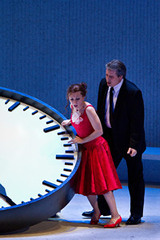| Opera Reviews | 26 April 2024 |
Dessay finds intimacy and pathos in Violettaby Steve Cohen |
|
| Verdi: La Traviata Metropolitan Opera April 2012 (HD performance) |
|
|
Some critics have complained that Dessay lacks a large voice and that at 46 she is missing the brilliant sparkle of her youth. She briefly cracked on one note in Sempra libera but throughout the opera she sang with intimacy and pathos, creating a touching character. With her gaunt face, slender figure and thinnish voice, Dessay seemed just right as a desperate party girl for whom the party is almost over. For comparison, interpreters of Violetta run the gamut from larger-than-life, like Joan Sutherland, to fragile, like Maria Callas. In this continuum, Dessay belongs in Callas's company. I mean no disrespect to Sutherland, who was convincing in her own way, but Verdi must have imagined a heroine more like Callas or Dessay. Violetta is a unique creation of Verdi's, as she inhabits a lonely world, shunned by polite society and even, for a while, by Alfredo. Clearly, Verdi was thinking of his own beloved Giuseppina Strepponi. She was a soprano in the twilight of her career who already was the mother of three illegitimate children when they became lovers after the early death of Verdi's wife. His cohabitation with Strepponi was regarded as scandalous. Dessay's Ah fors e lui was more pensive than most renditions. When she sang the title line she neatly segmented it in a breathless fashion. She attempts to defy death, almost hysterical as she sings her ascending coloratura scales. Dessay's internalized interpretation benefited from close-up videography. Violetta's race against time, and against death, was made vivid by the presence of a giant clock. And the normally-small role-player of Dr. Grenville hovered over the action, reminding us how seriously ill Violetta is. The clock caused us to notice, more than in the past, the musical ticking of time during the opera's overture. Matthew Polenzani, an accomplished and appealing artist, gave an ardent interpretation of Alfredo. He looked too mature for the role however; Alfredo is supposed to be noticeably younger than Violetta. As he tried to be intimately conversational, stretches of Dei mei bollenti spiriti were under pitch. It seemed as if his attempt at understatement caused the voice to lose some of its focus. This theory was born out when he sang the aria's cabaletta full-voice and stayed on pitch. Dmitri Hvorostovsky's singing was sensuous and exciting. His phrasing was superb, with meaningful linkage of lines and a wide range of color. He was equally appealing at full voice and when he reduced his volume to a whisper. Such great singing made us thankful that this production included Germont's usually-cut cabaletta to Di provenza il mar --- including both of the verses that Verdi wrote for it. Hvorostovsky looked dignified as Germont with his prematurely-white hair. More than in any previous production, this version of La Traviata focuses on Violetta by herself. The color scheme emphasizes this, with Violetta sometimes clad in red and everyone else in black. Most strikingly, everyone retreated when Violetta was about to die, which she did alone. Fabio Luisi's conducting could have used more propulsion and vigor; he leaned too heavily towards the soft and sentimental. The production's unique qualities were emphasized in this video which was directed by Gary Halvorson and which will be shown worldwide during May and later be available on TV and videodisc. |
|
| Text ©
Steve Cohen Photo © Marty Sohl / Metropolitan Opera |

 Here
is a rarity: a high-concept re-imagining that still seems logical. Willy
Decker's production is not the only way to do La Traviata, but
it is a convincing alternative, fortunately captured by high-def cameras
with the inimitable Natalie Dessay.
Here
is a rarity: a high-concept re-imagining that still seems logical. Willy
Decker's production is not the only way to do La Traviata, but
it is a convincing alternative, fortunately captured by high-def cameras
with the inimitable Natalie Dessay.





